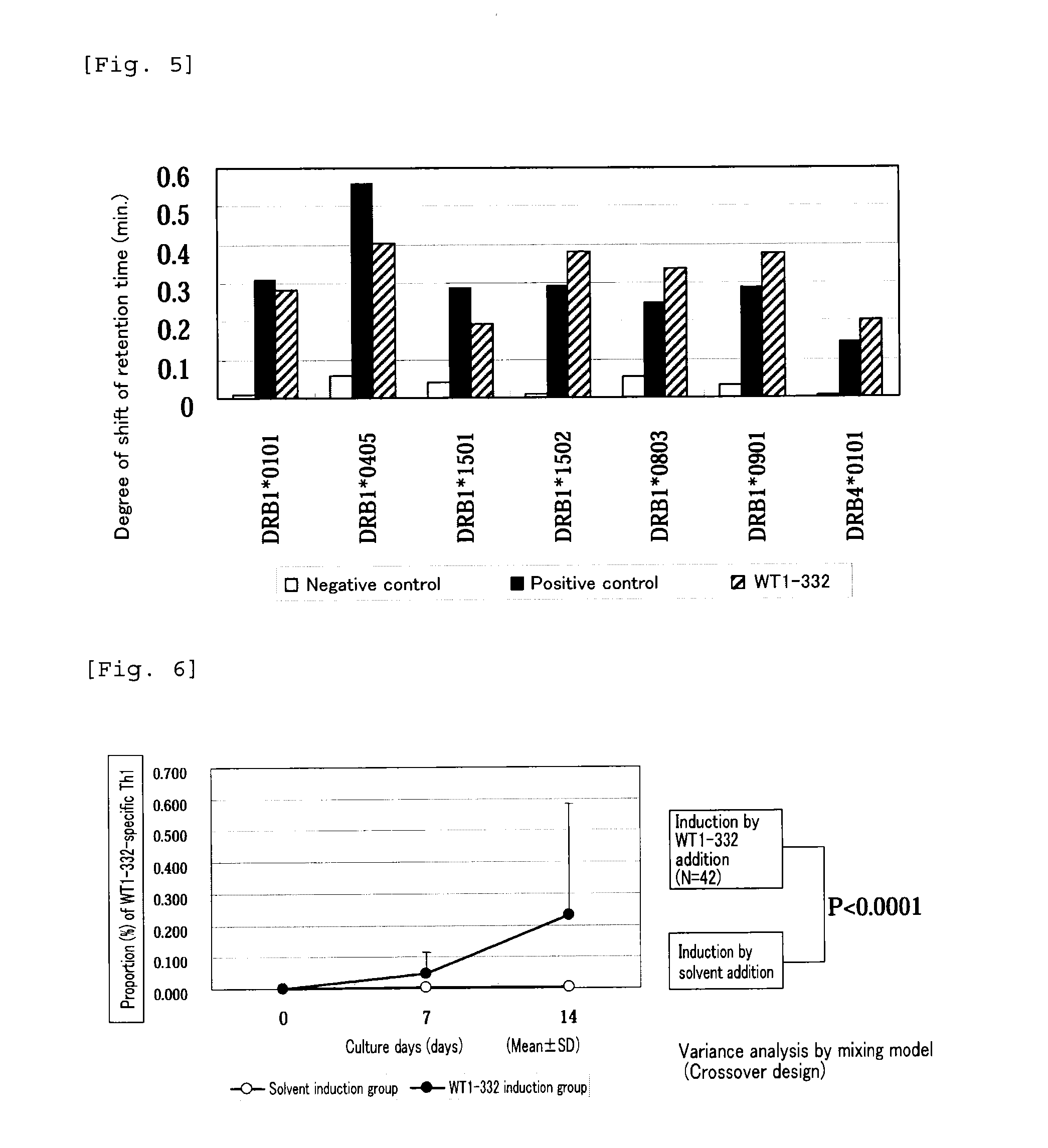Method for activating helper t cell
a technology of wt1 peptides, which is applied in the field of activating helper t cells, can solve the problems of difficulty in verifying whether or not wt1 peptides also have effects on other mhc class ii molecules
- Summary
- Abstract
- Description
- Claims
- Application Information
AI Technical Summary
Benefits of technology
Problems solved by technology
Method used
Image
Examples
example 1
1. Induction of WT1-332-Specific Type I Helper T Cells
[0077]Peripheral blood mononuclear cells (PBMCs) were separated from peripheral blood of healthy blood donors (donor 1: HLA-DRB1* 0406 / 1201-, DRB3* 0101-, and DRB4* 0103-positive, donor 2: HLA-DRB1* 0901 / 1101-, DRB3* 0202-, and DRB4* 0103-positive, donor 3: HLA-DRB1* 0401 / 0405-, and DRB4* 0102 / 0103-positive, donor 4: HLA-DRB1* 0901 / 1101-, DRB3* 0202-, and DRB4* 0103-positive). The separated PBMCs (1.5×107 cells) were suspended in a medium composed of 45% RPMI-1640 (SIGMA), 45% AIM-V (Invitrogen), and 10% AB type human serum (MP Biomedicals), and seeded on a 24-well plate at 1.5×106 cells / well (day 0). To the wells seeded with PBMCs, WT1-332 (a peptide consisting of the amino acid sequence depicted in SEQ ID NO:2) was added at a concentration of 10 μg / mL and IL-7 (PeproTech) at a concentration of 10 ng / mL, and the cells were cultured at 37° C. under 5% CO2 for one week. Also, a portion of the separated PBMCs was freeze-preserved f...
example 2
[0086]Next, in order to evaluate a binding ability of WT1-332 with MHC class II molecules, a folding test of 7 types of HLA class II monomer proteins (DRB1* 1501, 0101, 0405, 0803, 0901, 1502, or DRB4* 0101) with WT1-332 was carried out using HPLC. Briefly, a folding reaction solution was prepared by mixing an HLA class II monomer protein, a peptide [a peptide binding to each protein (positive control), a peptide not binding to each protein (negative control), and WT1-332], and a folding buffer. After reacting the solution at 37° C., the retention time was analyzed using HPLC. The folding with WT1-332 was evaluated by utilizing a shift of the retention time due to the binding of an HLA class II monomer protein with a peptide. Reagents used in this test are shown in the following table.
TABLE 1Reagents used in TestTable 1SupplierSuperdex200GE HealthcareSciencesFolding bufferMBLEquilibrating bufferMBLPositive control peptide:MBLPVSKMRMATPLLMQA (SEQ ID NO: 3)Negative control peptide:MBL...
example 3
Induction of WT1-332-Specific T Cells
[0092]Peripheral blood mononuclear cells (PBMCs) were separated from peripheral blood of healthy blood donors (in total 42 donors having at least one of HLA-DRB1* 1501, 1502, 0405, HLA-DPB1* 0501, and 0901). The separated PBMCs were divided into portions of 1.2×107 cells, suspended in a medium composed of 45% RPMI-1640 (SIGMA), 45% AIM-V (Invitrogen), and 10% AB type human serum (MP Biomedicals), and seeded on a 24-well plate at 1.5×106 cells / well (on the 0th day). To the wells seeded with PBMCs, WT1-332 was added at a concentration of 20 μg / mL and IL-7 (PeproTech) at a concentration of 10 ng / mL, and the cells were cultured at 37° C. under 5% CO2 for one week. A group in which a solvent (10 mM acetic acid) was added instead of WT1-332 at a final concentration of 10 μM (solvent induction group) was set as a control group. Also, a portion of the separated PBMCs was freeze-preserved for antigen presenting cells when re-stimulating.
[0093]After one we...
PUM
| Property | Measurement | Unit |
|---|---|---|
| Volume | aaaaa | aaaaa |
| Volume | aaaaa | aaaaa |
| Volume | aaaaa | aaaaa |
Abstract
Description
Claims
Application Information
 Login to View More
Login to View More - R&D
- Intellectual Property
- Life Sciences
- Materials
- Tech Scout
- Unparalleled Data Quality
- Higher Quality Content
- 60% Fewer Hallucinations
Browse by: Latest US Patents, China's latest patents, Technical Efficacy Thesaurus, Application Domain, Technology Topic, Popular Technical Reports.
© 2025 PatSnap. All rights reserved.Legal|Privacy policy|Modern Slavery Act Transparency Statement|Sitemap|About US| Contact US: help@patsnap.com



